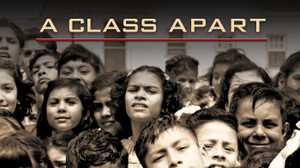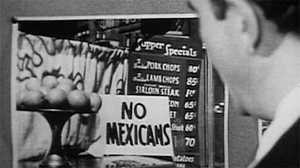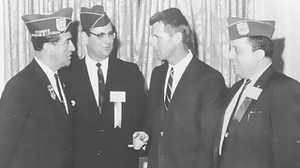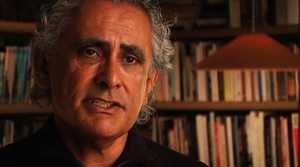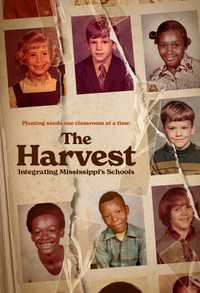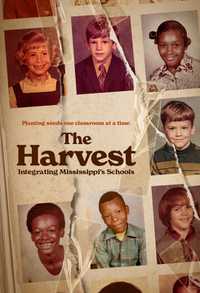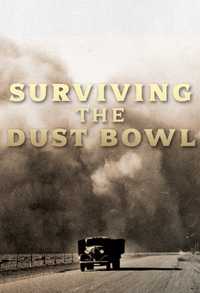Narrator: It happened in the small town of Edna Texas, the distraught woman told lawyer Gus García. Her son, Pete Hernández had been charged with murder.
“I accepted because I could not resist her tearful pleadings,” Garcia recalled, “and because I decided that we had an excellent opportunity to make this a test case.”
García knew the law, and he knew East Texas. He knew that the defendant’s fate would ultimately rest in the hands of an all-Anglo jury – a jury from which Mexican Americans would be systematically excluded.
The case, Hernandez v. Texas, would make an unlikely journey, all the way to the nation’s highest court.
Michael Olivas: It was an unusual ambition to take a case to the US Supreme Court. No Mexican Americans had ever tried a case in the US Supreme Court. They had no reason to believe that they would win.
Narrator: Garcia and his colleagues had a client who was by all accounts guilty — and a risky strategy that dared to put a crucial element of Mexican American identity on trial.
Lisa Ramos: I think many Mexican Americans were afraid, “What would happen if we weren’t considered white?
Narrator: What the Hernandez legal team was attempting was unprecedented – and had the potential to transform the lives of millions of Americans.
Ian Haney-Lopez: Hernandez v. Texas belongs in the pantheon of great civil rights cases. But even more important, it belongs in the pantheon of great moments in American history.
Wanda García: Life in the 1950’s was very difficult for Hispanics. We were considered second rate, we were not considered intelligent. We were considered invisible.
Bob Sánchez: It was overt discrimination, and not just, “You can’t belong to my country club” type, you know, but the … the real rough type. In theaters, in swimming pools, even in some public parks, we were segregated, something … something awful really.
Carlos Guerra: It got to the point where a restaurant association, put out a sign that said “No Mexicans, Niggers or Dogs Allowed.”
Narrator: Discrimination had become a harsh fact of Mexican American life over the one hundred years since the end of the Mexican War.
In 1848, the victorious United States acquired huge swaths of Mexican territory, and along with it, tens of thousands of residents who were offered American citizenship as part of the treaty ending the war.
Legal citizenship for Mexican Americans was one thing; equal treatment turned out to be quite another.
Many would lose their land to unfamiliar American laws, or to swindlers. With the loss of land came the loss of status.
Carlos, Guerra: Over two-three generations, the people who had owned vast ranches were suddenly farm workers.
After the Civil War, ever-larger numbers of Southern whites came into south Texas. All of a sudden you start seeing allegations that are cloned from the attitudes that they had in the Deep South about black people and see these values being applied to Mexicans … to Mexican Americans. “They’re shiftless. They’re lazy. They’re dumb. They don’t like to work,” and, you know, “They’re tryin’ to get your daughter.”
Narrator: Of mixed Spanish and Indian ancestry, Mexican Americans did not fit neatly into America’s ironclad racial categories, black or white. By the early 20th Century, they were considered white by law, largely owing to the treaty’s grant of American citizenship – but inz everyday life their status as citizens meant little.
Benny Martínez: A lotta Mexicans were killed for no reason at all! A lot of 'em were lynched, and a lot of 'em were just shot. Anybody with a cowboy hat then could be a ranger or a vigilante or a regulator.
Narrator: Segregation was widespread, enforced not by written laws – as was the case for African Americans – but by a rigid social code.
Michael Olivas: It was very clear that the social isolation was a perfectly symmetrical system, one that hermetically sealed Mexicans and blacks away from whites in all the daily aspects of life.
Wanda García: When we moved in the neighbors started getting upset. The kids would come on their bicycles and call us ‘dirty Mexicans, you eat toilets’. One time I said something really nasty to one of them and the father of this kid came up and asked me to step off the sidewalk so he could hit me.
Narrator: Discrimination followed to the grave. Cemeteries were segregated. Many funeral parlors even refused to prepare Mexican American bodies for burial.
Victor Rodríguez: So for the most part if you died, and if you were Hispanic, you had to be buried pretty quickly after you died so that you wouldn’t create a smell.
Narrator: In education, as in many other spheres, separate and unequal treatment was commonplace.
Benny Martínez: Our school were old schools. They were dilapidated. We had no toilet facilities inside. We had an outhouse. The Anglo children had a nice school, a modern school with indoor plumbin’ and heating so there was quite a difference. Quite a difference.
Narrator: Second-class treatment exacted a heavy toll.
Benny Martínez: They were always referring to us as “dirty Mexicans.” They called us “pepper belly.” They called us “greasers.” They called us “wet back.” They made us feel ashamed to be a Mexican American.
Ignacio García: And as long as Mexican Americans believed that they couldn’t do anything about that, then they in a sense reinforce the system, the social stratification that occurred in their lives.
Narrator: Then came World War Two. Three hundred thousand Mexican Americans served their country. They suffered casualties and earned honors disproportionate to their numbers. They returned home with dramatically raised expectations, believing they had earned the right to first class citizenship.
Dr Ramiro Casso: We went to fight to give people liberty and to give them their civil rights, and then we come back home and we find that it is the same way as we left it!
Carlos Guerra: A great many people, came home expecting that they had won their full citizenship rights. When they come home and they’re decorated war heroes and they’re turned away from restaurants or told to go to the balconies of theaters, it created a building resentment. When their kids were not allowed to go to the good schools, it created a great deal of resentment.
Narrator: The treatment of Private Felix Longoria, a war hero killed in the Philippines, became a flashpoint. When his body was returned to his hometown of Three Rivers, Texas, in early 1949, the town’s only funeral parlor refused to hold a memorial service – because, they told Longoria’s widow, “the whites wouldn’t like it.”
Dr Ramiro Casso: This guy gave his life so that we could have the same rights and privileges that are available to everybody, and he couldn’t be buried with the whites because he was brown? What the hell?
Ignacio García: And it it really hits a nerve in the nation in particular with many veteran groups who say how can they not allow him to be buried.
Narrator: For Mexican Americans, the Longoria incident came at a crucial time. Since the twenties, civic organizations such as LULAC – the League of United Latin American Citizens – had begun pushing for civil rights, with some success. Now, emboldened by their war experience and growing political clout, Mexican American activists pressed demands for broader change. After an intense public campaign, Felix Longoria was buried in Arlington National Cemetery.
Ian Haney-López: And it’s this generation who fought in World War Two who begin to demand civil rights for Mexican Americans. They form important social organizations like the G.I. Forum. These organizations are committed to fighting for equality for Mexican Americans as well as to fighting for pride in Mexican origins.
Narrator: The activists also took their fight to the courts. With the help of lawyers like Gus García and his colleague Carlos Cadena, both veterans, they began to attack the legal foundations of discrimination throughout the Southwest.
García led a team that won a court order curtailing the segregation of Hispanic students in Texas schools. Cadena won a ruling that ended restrictive covenants barring Mexican Americans from buying homes in Anglo neighborhoods. But those victories could only take Mexican Americans so far.
Ian Haney-López: Mexican American lawyers had achieved some successes on the state level, but the bottom line was the local majorities in these states were intent on treating Mexican Americans as second class citizens. If they were to be fully protected, if they were to be regarded as equal with other Americans, they would need to receive the protection of the Constitution. They would need to take their cases to the US Supreme Court.
Narrator: The lawyers faced an uphill battle. They knew that Mexican Americans had been denied the protection of the Constitution’s Fourteenth Amendment, an essential weapon for African Americans in their fight against discrimination. Some states had argued that the amendment only barred discrimination by whites against blacks – and by law, Mexican Americans were considered white.
To end the discrimination that stifled their community, they would need to find the right case – one with the potential to redefine the very meaning of the United States Constitution.
Narrator: On August 4, 1951, on the streets of Edna, Texas, the locals were taking advantage of a steamy day off. A tenant farmer named Caetano Espinosa, known to everyone as Joe, headed to Chencho Sánchez’s café on Menefee Street. Pedro Hernández, a field worker with a bad leg, was already inside.
Oralia Espinosa: It was a Saturday and I think it was my father’s birthday. And as we passed Edna he said, “I’m going to stop here to talk to the cotton pickers.”
Victor Rodríguez: I sat there at a table, and I ordered a Coke. And, ah all of a sudden I heard an argument. Joe Espinosa arguing with Pete … with Pedro. And when I heard the argument, I heard something to the effect that, Pedro el chueco cabrón, no woman is going to look at a cripple like you. They’re interested in a real he-man like me. And with that, Pedro left the cantina.
Juan Hernández: And we saw Pete walking towards his house. It was like he was in a daze. He didn’t even turn around and say, “Hi boys,” or anything. He just kept going. And so about twenty minutes later, here he comes with that rifle.
Victor Rodríguez: He came back, entered the cantina, and shot Joe Espinosa, in the heart.
Oralia Espinosa: He lived maybe thirty minutes after we got to the hospital. And my mother told me Caetano’s dead. It was just hard to believe. It was just incredible.
Narrator: In his law office in San Antonio, Gus García listened as Pete Hernández’s mother choked back sobs. García realized that there was more to this case than a small-town murder.
Bob Sánchez: Hernández was guilty as sin. No question, but they had been looking for a significant case which would bring about a ruling from the higher courts that segregation or discrimination against Mexican Americans would be illegal.
Narrator: The key issue for García was not whether Pete Hernández shot Joe Espinosa; it was that like many Latino defendants before him, Hernández’s fate would be decided by an all-Anglo jury.
Dr Ramiro Casso: There were 70 or more counties in Texas who had never had a Hispanic on a jury, just because, they didn’t think that we were capable of doing anything worthwhile. How do you get around the law that you have to be judged by a … a jury of your peers?
Narrator: García was convinced that this was the case that he and his activist colleagues had been waiting for. Gus García was not one to think small.
Bob Sánchez: You could write a book about, Gus. Fine-looking fellow, movie star-looking type, well dressed guy, brilliant.
Narrator: At 36, Gus García was already a local legend. The son of ranchers who could trace their Texas roots back to the Spanish crown, García was a dashing figure whose legal victories and glamorous social life had made headlines.
Eleanor McCusker: He was tall and he was slender, he had coal black hair and those green penetrating eyes that ah in my view made him very handsome.
Bob Sánchez: Gus was a silver-tongued orator. He had a deep resonant voice. Anything he said he said with authority.
Narrator: García had been an outstanding student at the University of Texas, captain of the nationally-ranked debate team; he had excelled at law school as well.
Still, even for Latinos with a stellar record like García’s, the doors to the state’s top law firms remained closed.
Ignacio García: There was only so far that you can go. There was a certain space provided them in which they could then fulfill some of their ambitions and dreams. So as good as they were, they saw the ceiling quite low outside of their community, but within their community I think they could fulfill much of their desires.
Narrator: Pete Hernández’s trial was set for October 8, 1951, in the Jackson County Courthouse. At the pre-trial hearing, García entered a plea of not guilty on behalf of his client. Then he raised an objection to the entire proceeding. He argued that Hernández was being denied a jury of his peers – that the practice of excluding Mexican American jurors, and the social hierarchy it reflected, were fundamentally unfair.
Ian Haney-López: If Mexican Americans had served on juries that judged whites, that would have up-ended Texas’s racial caste system. That would have said that Mexican Americans were the equal of whites, were capable of sitting in judgment on whites. And that I think is ultimately what the lawyers were fighting for.
Narrator: García soon realized it was not wise to wage legal war alone, in Edna, Texas, without some reinforcements.
Ian Haney-López: Texas had a phenomena called “sundown towns.” This name came from the idea that no minorities should be caught in town after the sun went down, at the penalty of violence.
Narrator: García called in John Herrera, an experienced Houston trial lawyer with a well-earned reputation for toughness.
Benny Martínez: Mr. Herrera was not afraid to speak out against anybody. He had big feet. He’d step on anybody. He wasn’t scared!
Narrator: Herrera brought along a young attorney, James DeAnda, to handle the statistical research.
Judge DeAnda: I did quite a bit of investigation on the case. And that county as it turned out there had never been a Hispanic in modern times ever served on either a grand jury, petit jury, or any other type of jury.
Narrator: García and his team pressed their case – armed with statistics proving the county’s history of systematic exclusion, and their lead lawyer’s sharp tongue.
Victor Rodríquez: They walked into the courthouse, and when they confronted the judge, the judge asked them if they needed an interpreter. And in his own articulate way, Gus García replied, “No, sir, if you can’t understand English or Spanish perhaps one of my colleagues can interpret for you.”
Henry Flores: When you bring a civil rights case, you’re challenging social convention and tradition and custom. And some people see it as a threat to, to, to a political structure, a social structure, a threat, to a way of life.
Eleanor McCusker: It wasn’t safe for them to stay there, because some of the people were very upset about the case, and what these lawyers were tryin’ to do. And, they thought it best not to stay there. They may not wake up there.
Martha Tevis: The men who were arguing the Hernandez case had to drive home to Houston every night from Edna, Texas. They didn’t dare stay in town.
Narrator: The first task the lawyers faced was to show a pattern of discrimination against Mexican Americans as a group.
To do that, they called Pauline Rosa, an Edna resident, to the stand. She testified that she had tried to enroll her U.S. born, English-speaking children in Edna’s all Anglo school only to be told, “They did not accept any Latin Americans.” Pressed by the prosecutor, she insisted, “They discriminated against me and my children.”
Lisa Ramos: For Pauline Rosa a Mexican American woman in Jackson County Texas to challenge the Anglo power structure was something pretty, pretty amazing. She saw that she could do something to effect change for her children.
Ignacio García: People have said, “She’s indicting the whole community,” but she was reflecting a view by Mexican Americans that while people might not individually say something or do something to them, collectively, they were happy with the system. I think all of them, both Anglo and Mexicans, understood very well what she was talking about in terms of “They all discriminate against me and my children.”
Narrator: During a pause in the proceedings, the Hernandez lawyers sought out a men’s room. They found one, on the courthouse grounds. But it turned out that there was a problem.
Michael Olivas: And the sign said men but a Mexican janitor whispered to them in Spanish that they couldn’t use it. And he told them in Spanish that there was another one “hazte pa’ca” out, out back. And they went downstairs and they find another men’s bathroom downstairs with a bathroom sign that says “Colored Men, Hombres Aqui” – “Men Here.”
Think of the irony of this. In the very courthouse where the state of Texas is arguing that Mexican Americans are white and, therefore, an all-white jury can convict a Mexican charged with murder, they can’t use the bathroom reserved for whites.
Ian Haney-López: They’re not lawyers who are operating above the fray, who are somehow independent of everything that’s going on; they, too, are subject to this racial system. In some real sense the lawyers in Hernandez v. Texas were themselves the clients.
Narrator: The judge overruled the defense team’s objection to the all white jury. It took that jury less than four hours to reach its verdict.
Pete Hernández was convicted of murder and sentenced to life in prison.
His lawyers immediately appealed. For them, the hard work was just beginning.
Narrator: In the spring of 1952, as they mapped out their strategy, García and Herrera realized they needed help. They turned to García’s longtime friend and former law partner, Carlos Cadena.
Henry Flores: These two guys together were probably the most powerful intellectual legal team that you could ever field.
Narrator: They made a kind of legal odd couple: García, charismatic and outgoing; and Cadena, scholarly and reserved.
Eleanor McCusker: Carlos was the quiet one, always doing the heavy research. Gus was the one always talking and making the changes, and I think that’s why they got along so well.
Narrator: After discussions with Latino civil rights activists, the Hernandez lawyers decided on a bold but risky legal strategy. Arguing for constitutional protection for Mexican Americans, they would emphasize their ambiguous and vulnerable place in America’s racial hierarchy. They would put their very identity on trial.
Ian Haney-López: Mexican Americans were fighting to be treated as if they were white. But the irony here is that the Texas Courts seized on their claim to be white not to treat them fairly but to continue to defend this practice of unfair mistreatment. The Texas courts responded by saying, “So you’re white. That’s fine. Look at the juries. There’s nobody but white persons on the jury. You have no claim of discrimination.” In turn, the Mexican American lawyers had to respond, “We’re white, but we’re a class apart. We’re a distinct class that though white, is being treated as if we’re not white.” And that’s the basis on which they went forward with their litigation in Hernandez v. Texas.
Narrator: The “class apart” theory was as controversial as it was innovative.
Lisa Ramos: I think many Mexican Americans were afraid, “What would happen if we weren’t considered white? How do we know we’re not going to be forced or pushed to identify with the black race, at a time when black people are fundamentally denied so many basic rights.” But there’s also the element of racism, of the belief among some Mexican Americans that blackness is inferior. So there’s an element of racism and there’s an element of fear of Jim Crow segregation.
Narrator: Carlos Cadena took the lead in drafting the Hernandez appeal. Writing a tightly argued legal brief, he elaborated on the novel theory of “a class apart.” He also punctured the state’s legal position – that Mexican Americans were white, and therefore outside the protection of the 14th Amendment – with a few well-placed rhetorical thrusts.“About the only time,” Cadena wrote, “that so-called Mexicans, many of them Texans for seven generations, are covered with the Caucasian cloak, is when it serves the ends of those who would shamelessly deny this large segment of the Texas population their fundamental rights.”
Texas’s high court was not persuaded. The appeal was denied. The next step for the Hernandez lawyers, and a very risky one, was to turn to the United States Supreme Court.
Michael Olivas: It was an unusual ambition to take a case beyond Texas and to take it to the US Supreme Court. Moreover, no Mexican Americans had ever tried a case in the US supreme courts. They had no reason to believe that they would win.
Ian Haney-López: The lawyers in Hernandez gambled when they decided to take this case to the Supreme Court. They knew, on the up side, that they could win national recognition for the equality of Mexican Americans, but they knew, on the down side, that if they lost, they would establish at a national level the proposition that Mexican Americans could be treated as second-class citizens. And not just that, they knew that this was probably their one shot in a generation.
Norma Cantú: An appeal to the Supreme Court of the United States is a costly matter. You have to pay a filing fee, you have to pay for the printing of the briefs, you have to pay to travel to Washington, D.C. to argue the case.
Eleanor McCusker: They didn’t even have money to get up there, much less to really fight the case. And all that time away from home and their practice all shot because they were dedicating so much time to the case.
Narrator: Activists issued a national appeal for funds. The Mexican American community was generally poor, but the Hernandez case struck a chord.
Ignacio García: The American GI Forum takes it to the people. Its founder and – and national president, Hector García, has a radio program. He gets on the radio and he starts pleading for donations. LULAC does it through its chapters across the Texas and the Midwest requesting money.
So what you find is people sending letters and saying, “this is the Wharton LULAC Council and we’re sending you $25.” There’s a group in Chicago that sends $25. And then you had these individuals who are … are donating money. There’s a gentleman who says, “I heard you on the radio and I’m sending you this money please let me hear my name as someone who stands up for Mexican American rights.”
Martha Tevis: At one time Carlos Cadena literally had tears in his eyes. He said, “They would come up to me and they would give you crumpled-up dollar bills and they’d give you coins. These were people who couldn’t afford it, but couldn’t afford not to.
Dr Ramiro Casso: We all dug deep into our pockets and through the dollar bill and—and—and fund-raiser and a dollar bill there, and we made it you know—we made it.
Narrator: The Hernandez team had another problem – one of their own.
According to the rules of the Supreme Court, the petition was due on January 20, 1953, and had to be professionally printed. The Hernandez petition arrived on January 21st, a day late, typewritten. Despite the Texas Attorney General’s repeated objections, the Supreme Court decided to accept the submission. But it was a close call – and a troubling indication that something was seriously wrong.
Ignacio García: Gus García had a … a problem, ah with alcohol. Quite young in his life, ah, most people perceived he was an alcoholic and … and some of the discussions among reformers is can Gus García handle this opportunity.
Narrator: The activists who had backed the lawyers’ efforts for so long, began to worry out loud. Finally, they had the case they wanted before the United States Supreme Court. But perhaps, after going all this distance, Gus García would not be up to the challenge.
Ignacio García: I think in some ways, Mexican Americans were … were also intimidated by the process and said, you know, we’ve got to be up to it. We’ve really gotta look good there. We’ve gotta, seize the opportunity, and is Gus ready to do that?
Narrator: The case of Hernandez v. Texas was scheduled for oral argument before the Supreme Court and its new Chief Justice, Earl Warren, on January 11, 1954.
Gus García arrived in Washington early to prepare.
Time enough, it turned out, to give his doubters more cause for concern.
García knew that lawyers for the NAACP, led by Thurgood Marshall, had recently appeared before the Court, arguing the landmark school desegregation case, Brown v. Board of Education.
Hoping to keep up with the better-funded civil rights group, he retained a publicist and a hotel suite his team could ill afford.
Ignacio García: Gus García was looking at the issue and he–and he wanted the kind of support that African Americans had gotten. And the other reformers were dealing with the realities. That is, “We can come up with maybe $3,000 and that barely covers what we have to do.”
Narrator: Soon García was joined by the rest of the legal team, including John Herrera and Carlos Cadena.
Gloria Cadena: Carlos got to Washington and Gus had taken a hotel room for him. He had a bartender and he had a table set up with drinks and everything. Carlos was pretty furious cause they were on a short budget and Gus thought nothing of spending the budget because it was partly his.
Martha Tevis: Cadena went out to the airport to meet a man who was bringing money from San Antonio and the man said “how’d you like the money that we sent?” And he said, “Well there isn’t any of it left.” The man gave him several hundred dollars more and they both agreed that they would not tell Gus about the money. Cadena said, “Gus García was a scoundrel, and he was a liar.”
Narrator: January 10th, the final night before the oral argument. The next morning, Gus García would argue the case of a lifetime, a case that would determine not only his own reputation, but the future of the community that depended on him.
Sometime that night, García managed to evade the watchful eyes of his nervous colleagues.
Mike Herrera: He went off on a toot, and everybody knew but nobody knew where he was. And, ah, Gus shows up sometime rather late in the morning and he is very, very drunk.
Lisa Ramos: They knew they were about to face the Supreme Court Justices in a few hours, and here’s this man putting the case at risk. He was one of the two main lawyers who was going to speak before Chief Justice Earl Warren and the other Justices.
Mike Herrera: They threw Gus in a cold shower clothes and all. Ordered room service, a big pot of black coffee and, and went on to sober him up and, and get him ready.
Narrator: On January 11, as the lawyers marched up to the Supreme Court, the wintry chill reminded them that Texas was very far away indeed.
The lawyers were about to face a Court that had never before been addressed by Mexican American attorneys, or been asked to consider the question of Mexican American civil rights.
Ignacio García: If you can imagine Carlos Cadena and Gus García getting the opportunity that no one else has ever had, to be able to paint a picture of a community and where it stood in time, and all of the–the practices, the laws, the–the circumstances that keep them where they were.
Norma Cantú: “Carlos Cadena sitting at the counsel table wearing a very dark serious suit, Gus García sitting next to him. The nine justices sitting on a long bench facing the two sets of parties. The Texas Attorney General sitting at their own table ready to defend the state’s decision that Mexican Americans were really Whites.
Ian Haney-López: The lawyers in Hernandez needed to argue that the 14th Amendment protected Mexican Americans to a court that had barely ever heard of Mexican Americans.
Carlos Cadena: I opened the argument and I said “Your petitioner is a … an American citizen of Mexican descent” and one of the judges asked me “What is that?” “What the-you stupid guy everybody knows what that is!” But anyway I was explaining and Justice Frankfurter interrupted and said “they call him greasers down there don’t they?”
Ignacio García: Gus García who seemed to be “out of it,” during most of the presentation by Carlos Cadena, was suddenly awoken by, several questions that were asked by the judges – can Mexican Americans speak English, are they citizens? And I think was the key for … for Gus García, because Gus García tended to personalize that and he saw within himself all the abilities and qualities of the Mexican American community.
Narrator: Fueled by indignation, García offered the justices a brief irony-laced history lesson. “My people,” he told them, “were in Texas a hundred years before Sam Houston, that wetback from Tennessee.” And he was just getting started.
Bob Sánchez: Gus’s delivery was so eloquent, it was so beautiful, so penetrating, so down to earth in high…spun…legal argument.
Mike Herrera: There are some lights there on the rostrum and when the red light comes on, you stop. And everybody knew that. When the red light came on, Gus stopped in mid-sentence. And then Justice Earl Warren leaned off the bench and said, “Continue, Mr. García”.
John J. Herrera Audio: Gus García was told to proceed. So he stole sixteen extra minutes. So when we walked out of the Supreme Court of the United States he met with one of the attachés and the attaché was an old black man he says ‘this is unprecedented’ he says they’ve never even given extra time here to Thurgood Marshall and he was here last week.
Narrator: After years of planning and all the legal work, it was finally over. The case that the activists and lawyers had focused on for so long was now out of their hands. The exhausted Hernandez legal team headed home to await the court’s decision.
Soon after their return, García and Herrera went on the radio to share their tale with the public that had supported them with their dollars and their prayers.
Gus García Audio:
Para mi fue una gran satisfacción participar en este caso y decirles las verdades a los señores magistrados de la suprema corte en Washington. Y acuérdate Johnny que ni a ti, ni a Carlos Cadena ni a un servidor, nos han faltado palabras jamás para defender nuestros derechos.
Slate (translation): It was very gratifying to be part of this case and speak the truth to the Supreme Court justices in Washington. And remember Johnny, neither you, nor Carlos Cadena, nor I have ever been at a loss for words to defend our rights.
Narrator: Finally, on May 3, 1954 the United States Supreme Court announced its ruling in the case of Hernandez v. Texas.
The decision of the Texas court was reversed. Pete Hernández would receive a new trial, before a true jury of his peers – a trial that would ultimately result in his reconviction for the killing of Joe Espinosa.
But far more important was the Court’s legal reasoning – a holding that Mexican Americans, as a group, were protected under the Constitution’s 14th Amendment, in keeping with the theory that they were indeed “a class apart.” It was a victory for the ordinary people who had endured discrimination without recourse for generations, and the activists who had fought on their behalf.
For Carlos Cadena, the meticulous legal theorist.
And for Gus García, who had disproved the doubters, and triumphed despite his inner demons. Hailed as heroes, the Hernandez lawyers were applauded by Mexican Americans across the Southwest.
Ignacio García: In every place they went and spoke, it was about, “Look at what Mexican Americans have done. Look at what – how we presented our case to the nation. Look at how we have finally made the people of the United States listen. Now they know we’re here.”
Ian Haney-López: The victory in Hernandez was huge for the Mexican American community. They now had the highest court in the land saying it’s unconstitutional. Indeed, symbolically it’s un-American to treat Mexicans as if they’re an inferior race.
Narrator: With the decision and the power of the United States’ Constitution behind them, Mexican Americans successfully challenged employment and housing discrimination; they tore down barriers to their right to vote and run for office; they ensured that their children would no longer be forced to attend segregated schools.
Carlos Guerra: This case is incredibly important because it guarantees that even being different that we are still protected under the laws of this great land. I think Mexican Americans in particular, Latinos in general but America as a whole owes a great debt to the people who pursued this case.
Narrator: For Gus García, the future would be shadowed by tragedy. Not long after his legal triumph, his personal life spun out of control. Alcoholism would be cruelly compounded by mental illness, taking García in and out of institutions for the next decade.
Eleanor McCusker: I didn’t see him those last few months when they said he was just beyond himself in San Antonio.
Dr Ramiro Casso: All the reports that I got back were that his mind was deteriorating; that his behavior was changing. And he died on a bench. Isn’t that tragic, I mean somebody with such a brilliant mind, my God.
Narrator: Gus García died of liver failure in 1964, at age 48.
Less than a year later, Carlos Cadena would be named the first Mexican American justice of the Texas Court of Appeals, and would go on to become Chief Justice.
After the Hernandez case, Mexican Americans across the country would no longer be considered second-class citizens under the law. The struggle was hardly over, but the lives of millions of Americans had been changed forever.
Ian Haney-Lopez: Hernandez v. Texas belongs in the pantheon of great civil rights cases, indeed of great American cases. But even more important, it belongs in the pantheon of great moments in American history. This is a moment when a people long regarded as inferior, organize and demand equal treatment and succeed in that demand. This is an inspirational moment in American history, a moment in which equality is demanded and achieved.
